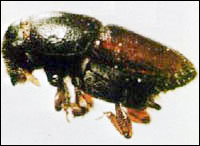

Dutch elm disease is the most destructive disease of elms in North America. Originally transferred to Europe from the Dutch East Indies and then brought to North America, it was first observed in the United States in Ohio in 1930.
The disease is caused by the fungus Ophiostoma ulmi, which is spread by the European elm bark beetle and through root grafts (interconnected roots). Elms within 30 feet of each other are at the greatest risk for spreading the disease through root grafts.
The European elm bark beetle spreads the disease when it carries fungal spores on its body from tree to tree. The beetle feeds on a tree, causing wounds that expose water-conducting vessels of the tree to fungal spores. The fungus then grows and spreads throughout the xylem (the tissue that carries water and nutrients throughout the tree). Infected trees initially show wilted and yellow leaves. Discolored bark is also an indication of the disease. If a tree is infected, a brown stain often develops in the outer annual ring. As the disease progresses, leaves and branches, and eventually the entire tree, die.
There is currently no cure for Dutch elm disease, although there are ways to prevent it from spreading. The best methods to controlling its movement include removing infected trees, controlling the European bark beetle population, and preventing root grafts. Although they do not cure the problem, fungicides are available for macro infusion into the trunk, providing up to three years of protection against Dutch Elm Disease infection.